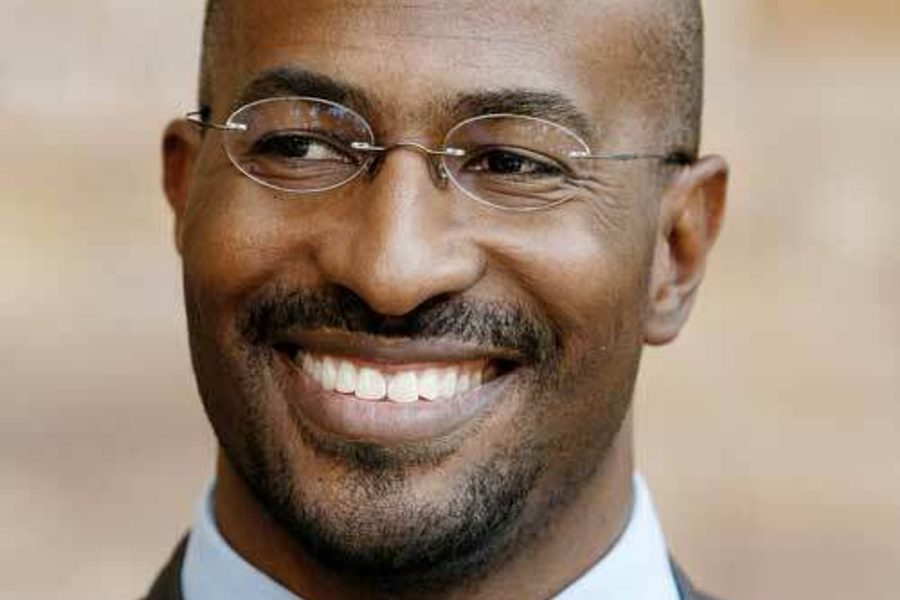Working on a Dream
Activist Van Jones explains how progressives can best the Tea Party.
Aaron Krager

Born the same year Martin Luther King Jr. and Robert F. Kennedy were assassinated, Van Jones is a champion of the poor, the environment and – since launching a new national campaign in June – the American Dream. Jones, author of The Green Collar Economy, served in the Obama administration as “green jobs advisor” in 2009, until Glenn Beck falsely accused and vehemently attacked him for being a 9/11 truther. He resigned his post and began studying the Tea Party movement.
Now, two years later, Jones has partnered with progressive organizations like MoveOn, labor unions, advocacy groups and blogs to develop the Rebuild the American Dream campaign – basically, a liberal version of the Tea Party – which tries to shift political leaders’ focus from budget austerities to struggling Americans. I spoke with Jones at a Clinton Global Initiative meeting in late June, and followed up with him a month later to discuss his latest progressive project.
You were demonized by the right and forced out of your job. Do you think progressives should use similar tactics (with the truth, rather than lies) against conservatives?
I think that we should be willing to tell the truth with the same audacity that they are willing to tell their lies. That said, I don’t think we are ever going to out-ugly our opponents. I think that what we need is a tough-minded idealist – a Bobby Kennedy. Somebody who won’t back down from a fight but who is clearly motivated by higher ideals than just being in the fight.
What is the American Dream and how should it be rebuilt?
Dr. Martin Luther King says in his speech, “I have a dream.” Then he says, “It is a dream deeply rooted in the American Dream.” He was talking about the idea that an ordinary person, without a fancy name, could work hard and get somewhere in our country and give their kids a better life.
That’s the American Dream – but there are people in this country who are trying to kill it. These dream-killers have wrapped themselves in a mantel of cheap patriotism, but their agenda is a wrecking ball to every institution that has made America great. A wrecking ball for the unions, a wrecking ball for the safety net, a wrecking ball for public education, a wrecking ball for everything that has made America exceptional. My view is that the Tea Party used the tools of democracy very well to hijack the conversation and make the solution to every problem more cutbacks. I think we should use the tools of democracy to take the conversation back.
Is that going to take policy changes?
It will take ideas and solutions that resonate with the American people. For example, tax those lightning-fast trades run by computer algorithms on Wall Street. If you tax them at one tenth of a penny you could take tens of billions off of Wall Street and use that to invest in America. There’s not a single person in America who doesn’t work on Wall Street who’s going to say that’s a bad idea. We could go back to the Clinton era tax rates on wealthy people and get $80 billion in two years. That’s not socialism, that’s the ’90s.
What about moving back to pre-Reagan-era tax rates?
Well, sure, just as long as we don’t stay stuck on stupid. I mean, where you draw the line is a function of both policy and politics. You can increase revenues. You can also reduce expenses. But no American family would say, ‘We got a budget problem, let’s starve Grandma. … Let’s starve the dog and the kids.’
Imagine if you had $3.3 billion – one week of expenses in Iraq and Afghanistan. We could take that $3.3 billion and do some nation-building right here in America. Unbelievable amounts of greed and malfeasance from Wall Street and neglect from D.C. … have left ordinary Americans lost, confused and angry. People in red states and blue states agree that we are a better country than this. If you make it concrete – how can we make America better? – people get excited.
Why try to revive a concept – the American Dream – that may never have been a reality for most Americans?
We are not trying to champion the American fantasy that everyone is going to be rich and buying things is going to make you happy. Most Americans see the best of the American Dream as part of our identity. In a crisis we don’t turn on each other, we turn to each other. For ordinary Americans, that is the cornerstone of their expectations about what it means to be an American. For that to be thrown under the bus, mainly so rich people and corporations don’t have to pay taxes, is heartbreaking for tens of millions of people.
What are the specific goals of your new campaign?
The first goal is to consolidate all of the causalities of the present economic crisis and turn them into champions for economic solutions, all under a common banner. That consolidation is key. Lots of economic fight-backs are happening across America. Workers are fighting against union-busting, veterans are fighting for better treatment coming home, young people are trying to keep their tuition down and get their job opportunities up. But the fights are scattered. If we keep fighting alone, we are going to keep losing alone.
The second goal is to use this crowd-sourced policy agenda we are on the verge of releasing, the Contract for the American Dream, to get elected officials and other influential people to sign on for an agenda of prosperity rather than austerity. We had 127,000 people crowd-source a jobs agenda with 10 main points of action. This came from 70 organizations across the country, 1,600 house meetings – twice as many meetings as the Tea Party when it launched in 2009. This contract will have tremendous moral authority because of the level of participation, and tremendous political impact because it will give people a sane economic agenda to rally around.
How do you create a progressive version of the Tea Party when there’s no progressive version of Fox News to deem your group newsworthy?
Our movements are more dynamic than that. What you are going to see is real innovation in communication where we once again match the conservative disinformation machine. It is a huge mistake to underestimate the creative capacity of progressives.
Why do we need an answer to the Tea Party? Why would we want that?
Just two years ago, most of us were feeling at least somewhat optimistic and encouraged about America’s future. Now we are mostly sad and morose. The main reason for that is the success of the Tea Party at hijacking Washington D.C.
We have to do everything we can to give the American people a coherent alternative – the America we thought we were voting for in 2008. Most people don’t understand that the Tea Party program … is really a ratification of the status quo of corporate rule.
I don’t think we should be discouraged at all. The right wing has this lopsided propaganda war against the achievements of the New Deal, … and they are losing in the polls. We should be quite hopeful that in an economy like this, when we haven’t put up a coherent alternative in the face of the most determined onslaught that we’ve seen in our lifetimes, that we are still at 60 to 70 percent in the polls.
What kind of leaders does this campaign need?
The good thing about the leadership of the American Dream movement is that it looks like America. We’ve got everybody from Planned Parenthood to Faithful America to the Sierra Club inside one network fighting for a better economy. Once we release the Contract for the American Dream, more voices will rally around it. More will lift it up and say this would be good for my community – I’m Latino, I’m lesbian, I’m a student, I’m Asian, I’m a farmer, but this contract would help me.
So the contract will lay out the goals. Is that how you expect groups to have their own specific leaders under one banner?
That is exactly the strategy. Part of what Rebuild the Dream is trying to be is a support center to help this massive movement consolidate. Part of what we have to learn is a new way of consolidating and realigning our best ideas.
How will this movement put people into positions of power so they can enact needed changes?
The Tea Party is a great example: It got people together based upon values and principles first, and then some people ran for office, some primaried Republicans, some people just focused on communications. The thing is, you have to be clear on your principles and values.





